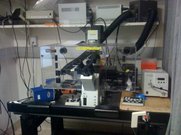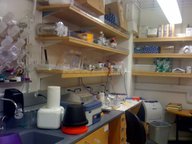"Find New Things"
"The science of living things is the science of movement and transformation". We are generally interested in neuronal trafficking and transport - trafficking in axons, dendrites and synapses.
Due to their complex geometry and finite sites of bulk protein synthesis in the perikarya, neurons have evolved elaborate transport and trafficking machinery to deliver proteins into axons and dendrites. Knowledge into the biology of this process is critical to our understanding of neuronal form and function. Disrupted trafficking is also a feature of many neurodegenerative diseases, and trafficking-routes can often be harnessed for therapeutic manipulations - underscoring their relevance to health and disease.
Focus areas:
1. Cell Biology of Neuronal trafficking/transport:
How are somatically-synthesized proteins delivered to their appropriate sites, and then retained there - for example at the synaptic terminal? Knowledge into the biology of this process is critical to our understanding of neuronal form and function. We are interested in unusual modes of trafficking employed by cytosolic ("soluble") and cytoskeletal proteins that comprise the majority of transported material, yet are the least studied among all transport cargoes; sluggishly moving in a mysterious rate-class called slow axonal transport.
2. Harnessing trafficking/transport for therapeutic avenues in Neurodegeneration:
A startling fact is that there is currently no reasonable disease-modifying therapy for any neurodegenerative illness, and drugs against seemingly well-characterized targets are failing in clinical trails. We believe that a major reason is a limited appreciation of the underlying biology. For instance, though it is well-accepted that many neurodegenerative diseases are due to a "gain of function", the actual normal function of most pathogenic proteins (APP, synuclein, huntingtin, etc.) is far from clear. We believe that basic questions underlying the pathways in neurodegenerative diseases can be answered by high-fidelity cellular models that accurately capture key pathophysiologic features of these diseases, along with concurrent examination of mouse models and human pathology. We are particularly interested in the workings of the small presynaptic protein alpha-synuclein in Parkinson's disease, and the trafficking of APP and BACE-1 - two marquee molecules involved in Alzheimer's disease.
Below is a generic description of our projects.
Due to their complex geometry and finite sites of bulk protein synthesis in the perikarya, neurons have evolved elaborate transport and trafficking machinery to deliver proteins into axons and dendrites. Knowledge into the biology of this process is critical to our understanding of neuronal form and function. Disrupted trafficking is also a feature of many neurodegenerative diseases, and trafficking-routes can often be harnessed for therapeutic manipulations - underscoring their relevance to health and disease.
Focus areas:
1. Cell Biology of Neuronal trafficking/transport:
How are somatically-synthesized proteins delivered to their appropriate sites, and then retained there - for example at the synaptic terminal? Knowledge into the biology of this process is critical to our understanding of neuronal form and function. We are interested in unusual modes of trafficking employed by cytosolic ("soluble") and cytoskeletal proteins that comprise the majority of transported material, yet are the least studied among all transport cargoes; sluggishly moving in a mysterious rate-class called slow axonal transport.
2. Harnessing trafficking/transport for therapeutic avenues in Neurodegeneration:
A startling fact is that there is currently no reasonable disease-modifying therapy for any neurodegenerative illness, and drugs against seemingly well-characterized targets are failing in clinical trails. We believe that a major reason is a limited appreciation of the underlying biology. For instance, though it is well-accepted that many neurodegenerative diseases are due to a "gain of function", the actual normal function of most pathogenic proteins (APP, synuclein, huntingtin, etc.) is far from clear. We believe that basic questions underlying the pathways in neurodegenerative diseases can be answered by high-fidelity cellular models that accurately capture key pathophysiologic features of these diseases, along with concurrent examination of mouse models and human pathology. We are particularly interested in the workings of the small presynaptic protein alpha-synuclein in Parkinson's disease, and the trafficking of APP and BACE-1 - two marquee molecules involved in Alzheimer's disease.
Below is a generic description of our projects.
The Slow Axonal Transport project: Exploring the Wild West of axonal transport

We are obsessed by the vexing problem of cytosolic slow axonal transport (nicely articulated here by Scott Brady). Specifically, while membranous proteins simply latch on to vesicles and are transported by motors in "fast" axonal transport, hundreds of soluble or cytosolic proteins are known to march along axons in a slow coherent manner, with overall velocities that are several orders of magnitude slower (called "slow" axonal transport). As diffusion cannot supply molecules over the enormous distances that exist in axons (diffusion also exponentially decays over time as it flows); this slow movement must use some motor-driven mechanism. However, almost nothing is known about how cytosolic proteins move in slow axonal transport. In our lab, we have developed new model-systems that allow us to visualize this phenomena (see paper) and over the next few years we hope to dissect the molecular mechanisms.
As many disease-associated cytosolic proteins also move in slow axonal transport (alpha-synuclein and tau for example), and their axonal transport has been implicated in disease (see reviews here and here), a related interest is to uncover the transport/trafficking of these cytosolic proteins under pathologic conditions.
These experiments involve extensive live imaging using photoactivatable vectors, sophistcated image-analysis, immunofluorescence, biochemistry, proteomics/bioinformatics (in collaboration with John Yates, Scripps) and computational modeling, as/if needed. As almost nothing is known about cytosolic transport, chances of making a new discovery - on virtually every carefully-executed experiment - is rather high. Read a review on this topic.
As many disease-associated cytosolic proteins also move in slow axonal transport (alpha-synuclein and tau for example), and their axonal transport has been implicated in disease (see reviews here and here), a related interest is to uncover the transport/trafficking of these cytosolic proteins under pathologic conditions.
These experiments involve extensive live imaging using photoactivatable vectors, sophistcated image-analysis, immunofluorescence, biochemistry, proteomics/bioinformatics (in collaboration with John Yates, Scripps) and computational modeling, as/if needed. As almost nothing is known about cytosolic transport, chances of making a new discovery - on virtually every carefully-executed experiment - is rather high. Read a review on this topic.
The alpha-synuclein projects: Connecting the dots

Alpha-synuclein is a tiny 14kDa protein involved in several neurodegenerative diseases including Parkinson's disease. Alpha-synuclein is normally enriched to presynaptic terminals. While there is little agreement among researchers on the exact pathologic processes, it is clear that excessive amounts of wild-type alpha-synuclein can be pathologic. Gene multiplications leading to increased protein levels cause disease in some families, and increases in alpha-synuclein protein levels are also seen in affected brain regions from patients with the sporadic forms of disease. Previous studies in our lab support the hypothesis that increases in alpha-synuclein levels result in synaptic dysfunction; specifically resulting in decreased neurotransmitter release.
We recently developed an experimentally tractable model-system to evaluate evolving alpha-synuclein-induced pathology in living neurons (see paper). In this system, a small (~ two fold) increase in human alpha-synuclein levels lead to synaptic deficits, including reduced neurotransmission, diminished recycling pools, and a curious decrease of presynaptic protein levels at the synapse. Projects in this domain are centered around unraveling the exact sequence of pathologic events that result from increased alpha-synuclein levels in neurons; culminating in decreased neurotransmitter release. A related area of interest is the normal role of alpha-synuclein at synapses.
We also find it interesting that though alpha-synuclein is a presynaptic protein under physiologic conditions, in diseased human brains, large amounts of the protein are found within the soma and proximal neuronal compartments. This leads to the hypothesis that axonal transport of alpha-synuclein is altered in pathologic states ("the synuclein paradox", reviewed here). Using the slow axonal transport model-systems described here, we aim to directly test if pathologic forms of alpha-synuclein are aberrantly transported. Tools used are: live imaging of transgenic neurons/animals, image analysis, immunofluorescence, biochemistry and electrophysiology.
We recently developed an experimentally tractable model-system to evaluate evolving alpha-synuclein-induced pathology in living neurons (see paper). In this system, a small (~ two fold) increase in human alpha-synuclein levels lead to synaptic deficits, including reduced neurotransmission, diminished recycling pools, and a curious decrease of presynaptic protein levels at the synapse. Projects in this domain are centered around unraveling the exact sequence of pathologic events that result from increased alpha-synuclein levels in neurons; culminating in decreased neurotransmitter release. A related area of interest is the normal role of alpha-synuclein at synapses.
We also find it interesting that though alpha-synuclein is a presynaptic protein under physiologic conditions, in diseased human brains, large amounts of the protein are found within the soma and proximal neuronal compartments. This leads to the hypothesis that axonal transport of alpha-synuclein is altered in pathologic states ("the synuclein paradox", reviewed here). Using the slow axonal transport model-systems described here, we aim to directly test if pathologic forms of alpha-synuclein are aberrantly transported. Tools used are: live imaging of transgenic neurons/animals, image analysis, immunofluorescence, biochemistry and electrophysiology.
The amyloid projects: A neuron is not a CHO cell

Picking up almost any review on the cell biology of Azheimer's disease (AD), one finds a detailed figure of the exact steps that are involved in the cleavage of the amyloid precursor protein (APP) into Amyloid-beta (Abeta) - a key step in the pathogenesis of AD, also called the "amyloidogenic pathway". All these processes occur within a neuron, yet surprisingly, virtually every detail regarding the cleavage and processing of APP is derived from studies in non-neuronal CHO cells.
A defining feature of neurons differentiating them from other cells is their polarized processes - the axons and the dendrites - and almost every known function of the neuron is critically related to this unique geometry (neurotransmission, for instance). Though work in CHO cells have given us meaningful insights into APP processing with a generic cell, the fact remains that the trafficking of APP/BACE in axons and dendrites, their sites of association/cleavage within these domains, and even their normal neuronal localization - are all open questions.
We believe that as we move forward, these questions are critical not only from a scientific standpoint, but also in designing focused therapeutic targets for AD. Ongoing studies in the lab are addressing these questions by live imaging, image analysis, immunofluorescence and biochemistry. Other projects are examining effects of Abeta oligomers on axonal transport. Read our recent publications on this topic here and here.
A defining feature of neurons differentiating them from other cells is their polarized processes - the axons and the dendrites - and almost every known function of the neuron is critically related to this unique geometry (neurotransmission, for instance). Though work in CHO cells have given us meaningful insights into APP processing with a generic cell, the fact remains that the trafficking of APP/BACE in axons and dendrites, their sites of association/cleavage within these domains, and even their normal neuronal localization - are all open questions.
We believe that as we move forward, these questions are critical not only from a scientific standpoint, but also in designing focused therapeutic targets for AD. Ongoing studies in the lab are addressing these questions by live imaging, image analysis, immunofluorescence and biochemistry. Other projects are examining effects of Abeta oligomers on axonal transport. Read our recent publications on this topic here and here.